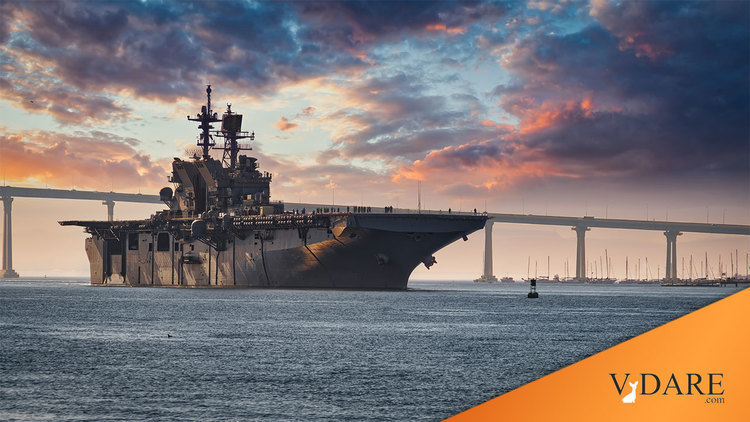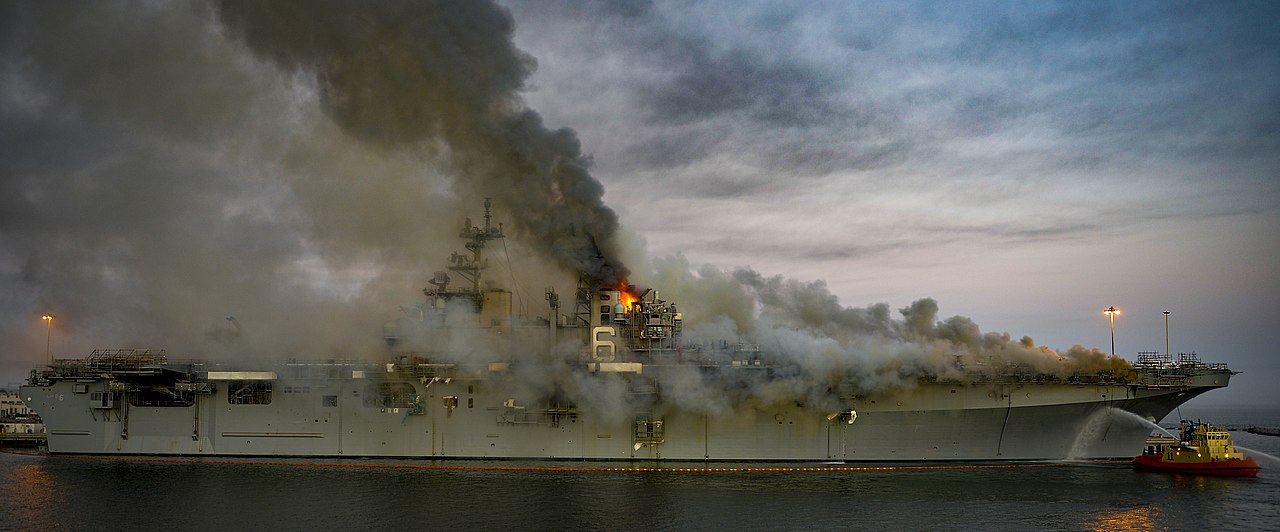
This Is Not Admiral Spruance’s U.S. Navy Anymore
10/22/2021
See, earlier: Diversity Sank My Battleship: Report Shows Navy Focusing On "Diversity", Not Shiphandling, Warfighting
When the Navy’s large amphibious assault ship / light aircraft carrier Bonhomme Richard, under repair in San Diego harbor, burned past hope of repair during July 2020, I speculated this multi-billion dollar disaster might have something to do with the Racial Reckoning.
I was wrong: the arsonist sailor was, apparently, a white guy upset over a romantic setback with a sailorette.
But, the U.S. Navy is supposed to be pretty good at putting out fires. In U.S. naval history, several of the most heroic passages are fire-fighting efforts that saved stricken ships from destruction. From USNI News:
By: Sam LaGrone and Gidget Fuentes
October 19, 2021 1:25 PM • Updated: October 20, 2021 6:03 AM
A cascade of failures — from a junior enlisted sailor not recognizing a fire at the end of their duty watch to fundamental problems with how the U.S. Navy trains sailors to fight fires in shipyards — are responsible for the five-day blaze that cost the service an amphibious warship, according to an investigation into the July 2020 USS Bonhomme Richard (LHD-6) fire reviewed by USNI News.
The investigation into the fire aboard Bonhomme Richard, overseen by former U.S. 3rd Fleet commander Vice Adm. Scott Conn, found that the two-year-long $249 million maintenance period rendered the ship’s crew unprepared to fight the fire the service says was set by a crew member.
“Although the fire was started by an act of arson, the ship was lost due to an inability to extinguish the fire,” Conn wrote in his investigation, which was completed in April and reviewed by USNI News this week. …
I would imagine that Xi Jinping had access to this report earlier than the U.S. public did and that it brightened his day.
Conn singled out 36 individuals, including five admirals, who were responsible for the loss of the ship due to either their actions on July 12 or lack of oversight leading up to the alleged arson. …
Conn highlighted the lack of adherence to the Navy’s special procedures for fire safety, which the service put in place after a 2012 arsonist fire resulted in the loss of attack submarine USS Miami (SSN-755), as a major cause of the fire.
“The considerable similarities between the fire on USS Bonhomme Richard (LHD-6) and the USS Miami (SSN-755) fire of eight years prior are not the result of the wrong lessons being identified in 2012, it is the result of failing to rigorously implement the policy changes designed to preclude recurrence,” Conn wrote in his report.
Navy officials have said little publicly about the resulting investigations into the fire’s cause and the firefighting response by the ship’s watchstanders, the base’s federal Fire Department crews and the local San Diego Fire Department. The investigation describes the overall response on the first day as disjointed, poorly coordinated and confusing. …
The first hint of trouble on July 12, 2020, came just after morning colors. Just after 8:00 a.m., a junior sailor walked through the upper vehicle deck as she headed out to a vending machine after her watch. She noticed a “hazy, white fog” in the lower vehicle deck around 8:10 a.m. But she didn’t report it, the investigation found, noting that “because she did not smell smoke, (the sailor) continued to her berthing.” …
Then a lot of confused, ineffectual things happened involving the crew for almost two hours before San Diego Fire Department firefighters arrived and, you know, fought the fire.
The fire had spread unabated for nearly two hours before the first firefighters — crews from the San Diego Fire Department — poured water onto the flames.
That happened at 9:51 a.m. on the upper vehicle deck, where the city firefighters on their own initiative attacked a fire along the space’s starboard side. While unfamiliar with the ship’s layout, they told investigators, they nevertheless reached one area of the fire and fought the blaze for at least another 30 minutes before conditions deteriorated with the fire’s continuing multi-fingered spread.
By then, the billowing smoke had turned heavy and black. One city firefighting official told his teams: “This compartment is about to blast.”
At 10:37 a.m., the on-scene command ordered all firefighting teams to evacuate the ship.
At 10:50 a.m., “approximately 90 seconds after the last firefighters had departed the ship, a massive explosion occurred” aboard, according to the report. The ensuing shock wave knocked down people on the pier and blew debris across to Fitzgerald, and massive smoke billowed high into the clear sky across San Diego Bay. …
“This explosion occurred after more than two hours of efforts where none of the ship’s installed firefighting systems were employed and no effective action was taken by any organization involved to limit the spread of the smoke and fires,” the lead investigator wrote in the executive summary. …
After an evaluation of what it would cost to repair the ship, the Navy decided to instead scrap Bonhomme Richard. …

